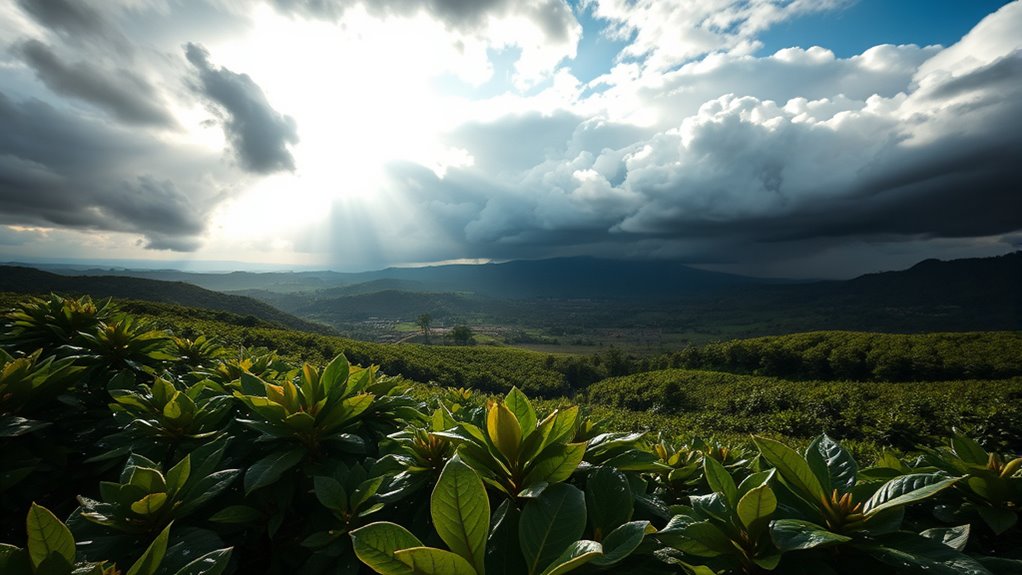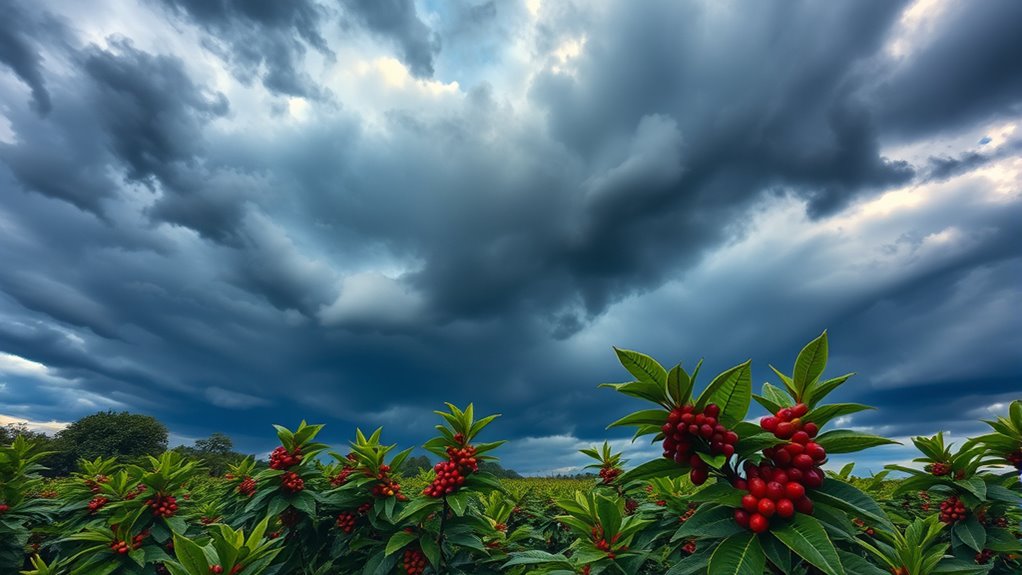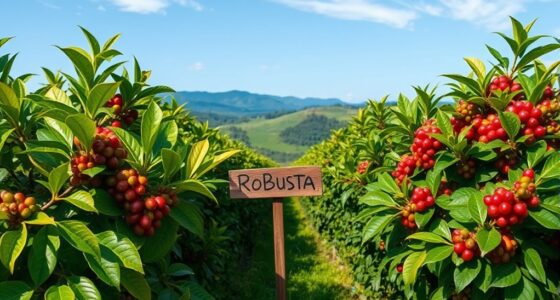El Niño and La Niña are climate patterns caused by changes in ocean temperatures in the Pacific that affect weather worldwide. During El Niño, warmer waters can lead to droughts in coffee-growing regions like Central America, reducing yields. La Niña usually brings heavier rainfall, which can cause flooding and damage crops. Understanding these patterns helps you grasp how climate swings influence coffee harvests and global weather. Stay with us to uncover more about these powerful climate influences.
Key Takeaways
- El Niño can cause droughts in coffee-growing regions, reducing yields and impacting supply.
- La Niña often brings increased rainfall, which may lead to flooding and damage coffee crops.
- Both oscillations influence temperature and rainfall patterns critical for optimal coffee cultivation.
- Predicting El Niño and La Niña helps farmers adjust planting and harvesting schedules to mitigate risks.
- Climate models improve forecasts of these patterns, aiding in managing coffee production under changing weather conditions.

Have you ever wondered why weather varies so much from day to day or place to place? One of the main reasons lies in the complex dance of tropical oscillations, which are patterns of climate variability that influence global weather systems. These oscillations involve shifts in atmospheric and oceanic conditions across the tropics, and they can cause considerable changes in temperature, rainfall, and storm activity. Understanding these patterns helps explain why some years bring droughts, floods, or unseasonal weather, affecting everything from agriculture to daily life.
Tropical oscillations, such as the El Niño-Southern Oscillation (ENSO), are prime examples of climate variability that dramatically impact weather worldwide. During an El Niño event, the central and eastern Pacific Ocean warms unusually, disrupting normal wind and ocean currents. This warming influences jet streams and weather patterns across continents, often bringing wetter conditions to the southern U.S. and drought to parts of Australia and Southeast Asia. Conversely, La Niña, which features cooler-than-normal ocean temperatures in the same region, tends to produce opposite effects, such as increased rainfall in Australia and drier conditions in South America. These oscillations don’t happen on a fixed schedule but cycle every few years, creating a pattern of climate variability that keeps weather unpredictable.
This climate variability means that weather is never static; it’s constantly shifting because of the interplay between ocean temperatures and atmospheric conditions driven by tropical oscillations. When these patterns change, they influence the jet streams, wind belts, and storm tracks, leading to fluctuations in weather from one season to the next. It’s like a massive, slow-moving engine that powers the climate, with the oscillations acting as the pistons driving the fluctuations. This connection explains why some years are more prone to extreme weather events, while others are relatively stable. Additionally, climate models help scientists predict how these oscillations might develop, improving forecast accuracy and preparedness.
For coffee growers and farmers, understanding these tropical oscillations is essential. El Niño and La Niña events can considerably affect crop yields by altering rainfall and temperature patterns. During an El Niño, droughts can diminish coffee production, while La Niña can bring heavy rains that cause flooding and crop damage. Recognizing these cyclical climate patterns allows farmers to prepare better, adjust planting schedules, and mitigate risks. Ultimately, tropical oscillations are a key part of climate variability, shaping the weather we experience and influencing industries and ecosystems around the world.
Frequently Asked Questions
How Do El Niño and La Niña Specifically Affect Coffee Quality?
El Niño effects can cause irregular rainfall and temperature swings, leading to inconsistent coffee bean development and potentially lower quality. La Niña impacts often bring droughts or excessive rain, which can stunt growth or cause mold and defects. You might notice flavor changes, with some batches becoming more acidic or less balanced. Both patterns challenge farmers to adapt, ultimately affecting the overall quality and taste of your coffee.
Can Weather Patterns Impact Coffee Prices Globally?
Sure, weather patterns like climate variability definitely shake up coffee prices worldwide. When nature plays its unpredictable game, supply chains falter, and markets panic—just what you need when your morning brew becomes a luxury. These shifts cause economic impacts, driving prices up or down unexpectedly. So, next time you sip your coffee, remember it’s not just flavor at stake but a global dance of climate chaos and market mayhem.
Are Certain Coffee Varieties More Resilient to Climate Fluctuations?
Yes, some coffee varieties are more resilient to climate fluctuations. You’ll find that varietal adaptation enhances climate resilience, allowing certain beans to withstand weather variability better. For example, Arabica plants with specific genetic traits can cope with temperature changes and droughts more effectively. By choosing resilient varieties, you help guarantee stable coffee production, even as climate patterns shift, supporting both growers and consumers in a changing environment.
What Long-Term Climate Changes Threaten Coffee Production?
You face long-term climate changes that threaten coffee production through rising temperatures, shifting rainfall patterns, and increased desertification risks. These changes lead to climate migration, forcing farmers to abandon traditional growing areas, and exacerbate desertification risks, reducing arable land. Together, these factors threaten coffee’s future, jeopardizing your supply chain, increasing costs, and demanding adaptation strategies to sustain coffee cultivation amid a changing climate.
How Do Farmers Adapt to Changing Weather Patterns?
You adapt to changing weather patterns by practicing soil management techniques that improve soil health and resilience, helping your crops withstand extreme conditions. Crop diversification is also key; by planting different varieties, you reduce risk and ensure steady income when some crops struggle. These strategies allow you to stay flexible, maintain productivity, and protect your livelihood despite unpredictable weather fluctuations.
Conclusion
So, next time you hear about El Niño or La Niña, remember these weather patterns actually influence coffee crops worldwide. Some experts believe these phenomena can boost or harm harvests, but the science isn’t settled yet. While there’s strong evidence linking them to climate changes, other factors also play a role. Keep an eye on weather forecasts—they might just tell you whether your favorite coffee will be abundant or scarce this season.









